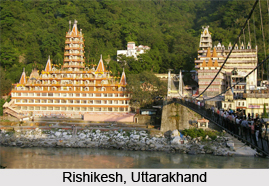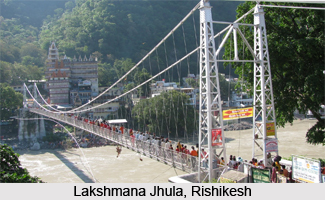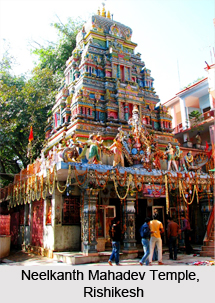 Rishikesh is a city, municipal council and "tehsil" (administrative division), located in the Dehradun district of the Indian mountainous state of Uttarakhand. In addition to being one of the most significant pilgrimage centres of India, Rishikesh is one of the most sought after tourism and adventure destinations in the country. It is a gateway to the Char Dham - Badrinath, Kedarnath, Gangotri and Yamunotri, being one of the access points to the Char Dham Yatra. The place is scenically located with the holy Ganga River flowing down from the Himalayas through it. It is also known as the "Gateway to the Garhwal Himalayas", being situated in the foothills of the Garhwal Range of Himalaya Mountains and "Yoga Capital of the World", having a plethora of ashrams and centres of yoga and meditation. People from the United States, Europe, China and Australia congregate in Rishikesh to enlighten themselves with lessons on yoga in "asanas" and "kriyas" and meditation, to lead a healthy life. The place catapulted to Western fame when the Beatles had dropped by for a visit to Maharishi Mahesh Yogi`s Ashram, now closed.
Rishikesh is a city, municipal council and "tehsil" (administrative division), located in the Dehradun district of the Indian mountainous state of Uttarakhand. In addition to being one of the most significant pilgrimage centres of India, Rishikesh is one of the most sought after tourism and adventure destinations in the country. It is a gateway to the Char Dham - Badrinath, Kedarnath, Gangotri and Yamunotri, being one of the access points to the Char Dham Yatra. The place is scenically located with the holy Ganga River flowing down from the Himalayas through it. It is also known as the "Gateway to the Garhwal Himalayas", being situated in the foothills of the Garhwal Range of Himalaya Mountains and "Yoga Capital of the World", having a plethora of ashrams and centres of yoga and meditation. People from the United States, Europe, China and Australia congregate in Rishikesh to enlighten themselves with lessons on yoga in "asanas" and "kriyas" and meditation, to lead a healthy life. The place catapulted to Western fame when the Beatles had dropped by for a visit to Maharishi Mahesh Yogi`s Ashram, now closed.
Etymology of Rishikesh, Uttarakhand
Rishikesh derives its name from Lord Hrishikesha, as who Lord Vishnu appeared to Raibhya Rishi, as a result of his rigorous penance. "Hrishikesha" is another name of Lord Vishnu, the term being a Sanskrit concoction of words "Hrishika" meaning senses and "Isha" meaning master or Lord. The term, therefore, literally means "Lord of the Senses".
History and Legends of Rishikesh, Uttarakhand
 Rishikesh was a tranquil spot for the "rishis" (sages) to meditate. It is said that in the 9th Century AD, Adi Shankaracharya had visited this land. From the ancient times, the place is known to be the celestial abode.
Rishikesh was a tranquil spot for the "rishis" (sages) to meditate. It is said that in the 9th Century AD, Adi Shankaracharya had visited this land. From the ancient times, the place is known to be the celestial abode.
Rishikesh has been a part of the legendary Kedarkhand (the present day Garhwal). Legend has it that Lord Rama performed penance here to kill Ravana, the "asura" (demon) king of Lanka. Lakshmana, Rama"s younger brother, crossed the Ganges River at the point where the present Lakshmana Jhula bridge stands using a jute rope bridge. The Kedarkhand in Skanda Purana, also mentions the existence of Indrakund at this very point. The jute rope bridge was replaced by the Lakshman Jhula, an iron rope suspension bridge, in 1889, which got washed away in the 1924 floods and later replaced by the present stronger bridge. Another similar suspension bridge, Ram Jhula, was built in 1986 at the nearby Sivananda Nagar.
Several temples, ancient and contemporary, lie along the banks of the Ganges in Rishikesh. Shatrughna Mandir, Bharat Mandir and Lakshman Mandir are the ancient temples established by Adi Shankaracharya. Shatrughna Mandir is near Ram Jhula and Lakshman Mandir is near the Lakshman Jhula. It is also believed that in this sacred town, Bharata, brother of Lord Rama, performed severe penance and a temple known as Bharat Mandir was later erected at the site.
Location and Geography of Rishikesh, Uttarakhand
Rishikesh in Uttarakhand is bounded by three districts of the state - Tehri Garhwal, Pauri Garhwal and Haridwar. Situated along the banks of the River Ganga, Rishikesh is distanced nearly 25 kilometres north of the holy city of Haridwar and 43 kilometres southeast of the state capital Dehradun. Haridwar being about an hour south, Rishikesh is considered as a holy city by the Hindus. It is vegetarian by law, and meat and alcohol are banned in the city. Cows, which are considered sacred by the Hindus, roam freely in the streets and always have the right to impede traffic and move across.
The climate of Rishikesh is subtropical humid, with the average temperatures on Celsius scale as high as 39 degrees in summers and as low as 7 degrees during winters. The general weather, though, is relatively pleasant with being mostly sunny during the day and comparatively cold evenings. The place also experiences a good amount of rainfall during the monsoons, with the annual mean level at 1,539 millimetres.
Demographics of Rishikesh, Uttarakhand
According to the 2011 Census India report, Rishikesh had a total population of 1,02,138 inhabitants, constituting 54,466 males and 47,672 females. The sex ratio thus comes to around 875. The literacy rate was ascertained at 86.86 %, higher than the national average of 74.04 %. Rishikesh is the seventh most populous city and the largest municipal council in the state.
Places of Interest in Rishikesh, Uttarakhand
The town of Rishikesh is a melange of religion, tourism and adventure. Ever since the Beatles visited the ashram of Maharishi Mahesh Yogi in February 1968, Rishikesh became a magnetic attraction amongst the spiritual seekers. They composed many songs during their stay in the place. Several other prominent artists like The Beach Boys visited the town to contemplate and meditate, establish a peaceful connect with nature. Prince Charles visited Rishikesh in 2013 and participated in the enchanting Ganga Aarti experience. The "Yoga Capital of the World" has numerous yoga and meditation centres and it is said that meditation in this place brings one closer to attaining "moksha", as does a dip in the holy waters of the Ganges.
Besides the yogic and meditation facet, Rishikesh is also a popular centre for adventurous activities, particularly White Water Rafting, which is done here at medium to rough rapids of the Ganges (Class III to IV). Enthusiasts in India as well as abroad came to Rishikesh during the rafting season from March to September. It is also an ideal spot for hiking, backpacking, rock climbing, mountain biking and trekking. Mountain Biking can be enjoyed at Mohanchatti near the Lakshmana Jhula.
Rishikesh is also a pilgrimage town considered sacred by the Hindus. The temples and religious spots comprise:
Lakshmana Jhula
Lakshmana Jhula is a major attraction of Rishikesh. It was a hanging jute rope bridge until 1889, which is said to be crossed by Lakshmana. It was reconstructed with iron ropes to a length of about 140 metres in 1939 over the Ganges. A landmark of Rishikesh, it offers splendid views of the surrounding town. A similar longer bridge Ram Jhula is another landmark located 3 kilometres north of the city at Muni Ki Reti. Built in 1986, it stretches up to 230 metres.
Swarga Ashram
Distanced 2 kilometres on foot south of the Lakshmana Jhula along the east bank of the Ganges, is the spiritual community of Swarga Ashram, made up of temples, ashrams, a crowded bazaar, "sadhus" and bathing ghats where religious ceremonies are performed at sunrise and sunset. The vibrant Ganga Aarti is held at the riverside temple of the Parmarth Niketan Ashram every evening at 6.30 pm, with chants and lighting of candles.
Neelkanth Mahadev Temple
Pilgrims take water from the Ganges to offer at the Neelkantha Mahadev Temple, a 7 kilometre three-hour walk along a forest path from Swarga Ashram. Neelkanth (Blue Throat) is another name for Lord Shiva, based on the legend that says He drank poison from the sea churned by demons, which turned his throat blue. A much longer 17 kilometre road via Lakshman Jhula also goes to the temple.
Neer Garh Waterfall
Neer Garh is a striking waterfall, at the end of a 20-minute hike starting 2 kilometres north of Lakshmana Jhula.
In September 2015, the Union tourism minister Mahesh Sharma announced that Rishikesh and Haridwar will be the first in India to be given the title of "twin national heritage cities".



















